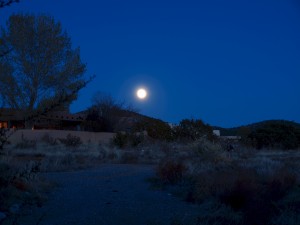
Full moon rising the other night. Just a bit of nostalgia.
I’m catching up a bit here, on photos and topics, both.
The other day (see?) I had an interesting Twitter conversation with the charming Abby Mumford. She announced to Twitter at large that she believed was done writing her novel. Then she asked how she should know if she was really done.
This might seem like a silly question. Duh – you’re done when the story is over. Thing is, when you’re writing, you don’t always know when the story is over. In fact, if you’re like most writers, the story doesn’t really end at all for you. You have this sense of the ongoing thread of your characters’ lives. Perhaps this crisis is over, but it’s not like they all fall over dead at the end, not unless you’re writing a Shakespeare tragedy.
(Even with those, the role-call of deaths in the final act begins to feel a bit contrived. Really, Will? EVERYONE??)
So, I told her that, if she’d tied up all her threads, then she was done. Even a thread that continues into the future needs a nice little knot at the end of a particular story. She thought they were, but she was feeling still unfinished. I finally suggested that she type “The End” if it made her feel better.
She did and it did.
This might seem like a false resolution, but endings, especially on first drafts, are moving targets. By the time you go back through the whole novel, cut, amplify, eliminate, massage and tighten, then ending might have moved by 45 degrees. Which is necessary, sometimes. I’ve heard that John Irving never starts a book until he knows the last line. But I also know, from reading about his process, that he revises over and over, getting to that ending.
For me, each book is different. Usually I have to write to find out how it all ends. With Middle Princess, I’ve had a pretty good idea how it ends, but I’ve been sneaking up on that ending for days now. In the past, when I’ve gotten close to the end, the words flow in a great, ultimate rush. Not so this time. I keep telling myself it doesn’t have to be perfect, that I’ll likely change it in revision. Still, it only feeds at a measured pace. I’m tying up the knots, one by one.
Soon, I know, I’ll be done.
 This weekend, my local RWA chapter, LERA, had our biannual conference. Two of our guests were Jennifer Enderlin, editor for the fabulous Darynda Jones at St. Martins, and NYT Bestselling author Deanna Raybourn. On Friday, Darynda and our two conference organizers, Tammy Baumann and Kari Bovee, made the trip up to Santa Fe. We did lunch and shopping and I got to play tour guide. Such a fun day for me!
This weekend, my local RWA chapter, LERA, had our biannual conference. Two of our guests were Jennifer Enderlin, editor for the fabulous Darynda Jones at St. Martins, and NYT Bestselling author Deanna Raybourn. On Friday, Darynda and our two conference organizers, Tammy Baumann and Kari Bovee, made the trip up to Santa Fe. We did lunch and shopping and I got to play tour guide. Such a fun day for me!

